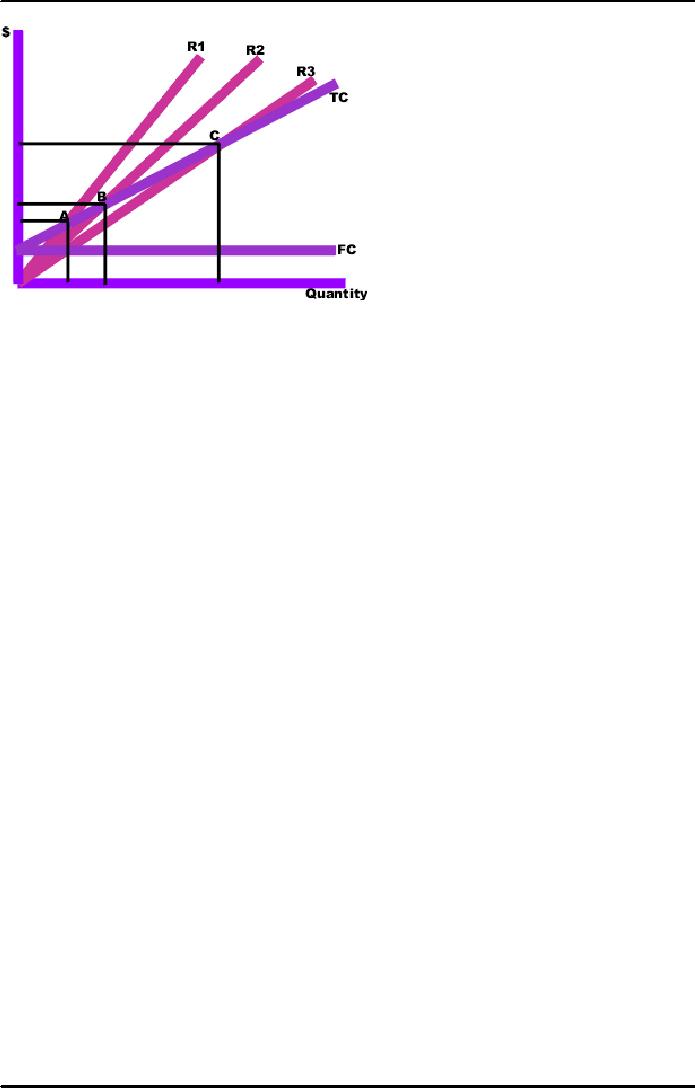 |

Corporate
Finance FIN 622
VU
Lesson
12
ADVANCE
EVALUATION METHODS
The
following topics will be
discussed in this lecture.
Advance
Evaluation Methods:
Sensitivity
analysis
Profitability
analysis
Break
even accounting
Break
even - economic
SENSITIVITY
ANALYSIS:
Sensitivity
analysis is the study of how the
variation in the output of a model
(numerical or otherwise)
can
be
apportioned, qualitatively or
quantitatively, to different sources of
variation.
A
mathematical model is defined by a series
of equations, input factors,
parameters, and variables
aimed to
characterize
the process being investigated. Input is
subject to many sources of uncertainty
including errors
of
measurement, absence of information
and poor or partial understanding of the
driving forces and
mechanisms.
This
imposes a limit on our
confidence in the response or output of
the model. Further, models may
have
to
cope with the natural intrinsic
variability of the system, such as the
occurrence of stochastic events.
Good
modeling
practice requires that the
modeler provides an evaluation of the confidence in
the model, possibly
assessing
the uncertainties associated with the
modeling process and with the
outcome of the model itself.
Uncertainty
and Sensitivity Analysis offer
valid tools for characterizing the
uncertainty associated with a
model.
Applications
Sensitivity
Analysis can be used to
determine:
1.
The model resemblance with the
process under study
2.
The quality of model
definition
3.
Factors that mostly contribute to
the output variability
4.
The region in the space of input
factors for which the model
variation is maximum
5.
Optimal - or instability - regions
within the space of factors
for use in a subsequent
calibration
study
6.
Interactions between
factors
7.
Sensitivity Analysis is popular in financial
applications, risk analysis, signal
processing, neutrals
networks
and any area where
models are developed.
Methodology
There
are several possible
procedures to perform uncertainty (UA)
and sensitivity analysis (SA).
The most
common
sensitivity analysis is sampling-based. A
sampling-based sensitivity is one in
which the model is
executed
repeatedly for combinations of values
sampled from the distribution
(assumed known) of the
input
factors. Other methods are
based on the decomposition of the variance of the
model output and are
model
independent.
In
general, UA and SA are
performed jointly by executing the model
repeatedly for combination of
factor
values
sampled with some
probability distribution. The
following steps can be
listed:
1.
Specify
the target function and
select the input of
interest
2.
Assign
a distribution function to the selected
factors
3.
Generate
a matrix of inputs with that
distribution(s) through an appropriate
design
4. Evaluate
the model and compute the distribution of
the target function
5.
Select a method for
assessing the influence or relative importance of each
input factor on the
target
function.
PROFITABILITY
ANALYSIS
Successful
financial institutions today are able to
effectively identify those
products, customers,
branches,
and
other factors that impact
overall profitability. But
discovering what's actually
profitable isn't always
straightforward. To
really understand what's driving bank
profitability, you need to be
able to drill down
into
the lowest level of detail, and analyze
data with ease and
precision.
Profitability
is a dynamic, accountable solution
for managing customer relationships
and measuring
37

Corporate
Finance FIN 622
VU
performance
providing a complete picture of
your organization's profitability. It
allows you to analyze
your
business across unlimited
dimensions. Beyond customer
profitability, product profitability
and
organizational
profitability, it's sophisticated, multi-dimensional
OLAP environment provides the
unique
ability
to calculate profitability at the account
level, drill up and down
through every level of the
hierarchy,
and
aggregate up for any
reporting or analytical dimension, for
improved accuracy and better
decision-
making.
This
flexibility allows you to
analyze...
Customers
who are 'at risk'
Performance
of an officer that supports
multiple business units
Business
unit performance across a
group of branches
Customer
households reported in multiple
market segments
Geographic
views that aren't aligned
with organizational units
Product
success across a group of
market segments
Origination
trends by groups of officers, branches,
or by market segment
BREAK-EVEN
ACCOUNTING
This type of
report is not one that is
automatically generated by most
accounting software, nor is it
one that
is
normally produced by your accountant,
but it is an important analysis
for you to have and
understand.
For
any new business, you should
predict what gross sales volume level
you will have to achieve
before you
reach
the break-even point and then, of
course, build to make a
profit. For early-stage
businesses, you
should be
able to assess your early
prediction and determine how
accurate they were, and
monitor whether
you
are actually on track to
make the profits you need.
Even the mature business
would be wise to look
at
their
current break-even point and
perhaps find ways to lower
that benchmark to increase
profits. The
recent
massive layoffs at large corporations are
directed at this goal, lowering the
break-even point and
increasing
profits.
Break-Even
Is the Volume Where All
Fixed Expenses Are
Covered:
You
will start a break-even
analysis by establishing all the
fixed (overhead) expenses of
your business. Since
most
of these are done on a monthly
basis, don't forget to include the
estimated monthly amount of
line
items
that are normally paid on a quarterly or
annual basis such as payroll
taxes or insurance. For
example, if
your
annual insurance charge is
$9,000, use 1/12 of that, or
$750 as part of your monthly
budget. With the
semi
variable expense (such as phone
charges, travel, and marketing), use
that portion that you
expect to
spend
each and every
month.
For
the purpose of a model break-even, let's
assume that the fixed
expenses look as
follows:
Administrative
salaries
$1,500
Rent
800
Utilities
300
Insurance
150
Taxes
210
Telephone
240
Auto
expense
400
Supplies
100
Sales
and marketing
300
Interest
100
Miscellaneous
400
Total
$4,500
These
are the expenses that must
be covered by your gross
profit. Assuming that the
gross profit margin
is
30
percent, what volume must
you have to cover this
expense? The answer in this
case is 15,000--30
percent
of that amount is $4,500, which is
your target number.
38

Corporate
Finance FIN 622
VU
The
two critical numbers in these
calculations are the total of the
fixed expense and the
percentage of gross
profit
margin. If your fixed
expense is $10,000 and your
gross profit margin is 25
percent, your
break-even
volume
must be $40,000.
This
Is Not a Static
Number:
You
may do a break-even analysis before
you even begin your business
and determine that your
gross
margin
will come in at a certain
percentage and your fixed
expense budget will be set at a
certain level. You
will
then be able to establish
that your business will
break even (and then go on
to a profit) at a certain level
of
sales volume. But your
pre-start projections and your operating
realities may be very different.
After
three
to six months in business, you should
compare projections to the real-world
results and reassess,
if
necessary,
what volume is required to reach
break-even levels.
Along
the way, expenses tend to
creep up in both the direct and
indirect categories, and you
may fall below
the
break-even volume because
you think it is lower than it
has become. Take your
profit and loss
statement
every
six months or so and refigure your
break-even target number.
Ways
to Lower Break-Even:
There
are three ways to lower
your break-even volume, only
two of them involve cost controls
(which
should
always be your goal on an
ongoing basis).
1.
Lower direct costs, which
will raise the gross margin.
Be more diligent about purchasing
material,
controlling
inventory, or increasing the productivity
of your labor by more cost
effective scheduling or
adding
more efficient technology.
2.
Exercise cost controls on your
fixed expense, and lower the
necessary total dollars. Be
careful when
cutting
expenses that you do so with
an overall plan in mind. You
can cut too deeply as
well as too little
and
cause
distress among workers, or
you may pull back marketing
efforts at the wrong time, which
will give out
the
wrong signal.
3.
Raise prices! Most
entrepreneurs are reluctant to raise
prices because they think
that overall business
will
fall
off. More often than
not that doesn't happen
unless you are in a very
price-sensitive market, and if
you
are,
you really have already
become volume driven.
But if
you are in the typical niche-type small
business, you can raise
your prices 4 to 5 percent
without much
notice of
your customers. The effect is startling.
For example, the first model we
looked at was the
following:
Volume
$15,000
direct
cost
10,500
70%
gross
profit
4,500
Raising
the prices 5 percent would
result in this change:
Volume
$15,750
direct
cost
10,500
67%
gross
profit
5,250
You
will have increased your
margin by 3 percent, so you can
lower the total volume you
will require to
break
even.
The Goal Is
Profit:
You
are in business to make a
profit not just break
even, but by knowing where
that number is, you
can
accomplish
a good bit:
� You
can allocate the sales and
marketing effort to get you to the
point you need to
be.
� Most
companies have slow months,
so if you project volume
below break-even, you can
watch
expenses
to minimize losses. A few really bad months
can wipe out a good bit of
previous profit.
� Knowing
the elements of break-even allows
you to manage the costs to
maximize the bottom
line.
Once
you have gotten this far in
the knowledge of the elements of your
business, you are well on
your way
to
success.
39

Corporate
Finance FIN 622
VU
The
breakeven
point in
economics is the point at which
cost or expenses and income
are equal - there is
no net
loss or gain, one has
"broken even".
The
point at which a firm or
other economic entity breaks
even is equal to its fixed
costs divided by its
contribution
to profit per unit of
output, which can be shown
by the following formula:
The
break even point is also the
point on a chat indicating the time
when something has broken
even, and is
a
general term for not having
gained or lost something in a
process.
The
Contribution per Unit can be
worked out using
Contribution
= Price per Unit - Variable
Costs per Unit
The
break
even point for a
product is the point where
total revenue received
equals total costs
associated
with
the sale of the product (TR=TC). A
break even point is
typically calculated in order
for businesses to
determine
if it would be profitable to sell a
proposed product, as opposed to
attempting to modify an
existing
product instead so it can be
made lucrative. Break-Even Analysis can
also be used to analyze
the
potential
profitability of an expenditure in a sales-based
business.
In
unit sales
If the
product can be sold in a
larger quantity than occurs
at the break even point,
then the firm will make
a
profit;
below this point, a loss.
Break-even quantity is calculated
by:
Total
fixed costs / (price -
average variable costs)
(Explanation
- in the denominator, "price minus
average variable cost" is the variable profit per
unit, or
contribution
margin of each unit that is
sold.)
Firms
may still decide not to
sell low-profit products,
for example those not
fitting well into their
sales mix.
Firms
may also sell products that
lose money - as a loss
leader, to offer a complete
line of products, etc.
But
if a
product does not break
even, or a potential product looks
like it clearly will not
sell better than the
break
even
point, then the firm will
not sell, or will stop
selling, that
product.
An
example:
Assume
we are selling a product for
$2 each.
Assume
that the variable cost associated
with producing and selling
the product is 60 cents.
Assume
that the fixed cost related
to the product (the basic costs
that are incurred in operating
the
business even if no product is produced)
is $1000.
In this
example, the firm would have
to sell (1000/ (2 - 0.6) =
714) 714 units to break
even.
In
price changes
By inserting
different prices into the
formula, you will obtain a
number of break even points, one
for each
possible
price charged. If the firm to
change the selling price for
its product, from $2 to
$2.30, in the
example
above, then it would have to
sell only (1000/(2.3 -
0.6))= 589 units to break
even, rather than
714.
40

Corporate
Finance FIN 622
VU
To
make the results clearer, they
can be graphed. To do this, you
draw the total cost curve
(TC in the
diagram)
which shows the total cost
associated with each
possible level of output, the fixed
cost curve (FC)
which
shows the costs that do not
vary with output level, and
finally the various total
revenue lines (R1,
R2,
and
R3) which show the total
amount of revenue received at each
output level, given the price you
will be
charging.
The
break even points (A,B,C)
are the points of intersection between
the total cost curve (TC)
and a total
revenue
curve (R1, R2, or R3).
The break even quantity at
each selling price can be
read off the
horizontal,
axis
and the break even price at
each selling price can be
read off the vertical axis.
The total cost,
total
revenue,
and fixed cost curves
can each be constructed with
simple formula. For example,
the total revenue
curve
is simply the product of selling price
times quantity for each
output quantity. The data
used in these
formulas
come either from accounting
records or from various estimation
techniques such as
regression
analysis.
In
potential expenditures Break-Even
Analysis can be used in the evaluation of
the cost-effectiveness of a
new
expenditure for a sales-revenue based
business. Here, the cost can be
evaluated in terms of
revenues
needed
to break even on the investment, or more
specifically, to determine how
much of an increase in
sales
revenues would be necessary to
break even.
An
illustrative example of this is a retail lumberyard
who is considering the purchase of a
delivery truck. The
goal
is to evaluate how large an
increase in sales revenue is
necessary to break even on the investment
in a
delivery
truck. For this example, the
company's front-door margin
(that is, sales revenue
minus the cost of
goods
sold and costs of doing
business) is 5%, and the cost of the
desired delivery truck is $50,000.
To
calculate
the break-even level of expenditure, the following
formula can be used:
Expenditure
($) = (Front-door margin %) X (Revenue
Increase needed to break
even)
To
break even using the above
example, $50,000 must equal
5% of the sales INCREASE ("SI") in
order to
break
even. The variable which
must be isolated is the Sales
Increase.
$50,000
= 5% of SI
$50,000
= .05 * SI
$50,000/.05
= SI
$1,000,000
= SI
Sales
increase of $1,000,000 is needed to
break even on the investment on the delivery
truck. The business
must
then decide how it can
use the delivery truck to help
increase sales by $1,000,000; if it
can, then they
will
break even, and if it can
not, then it would be an ill-advised
investment. If sales revenues pass
the
break-even
point, 5% of further increase
would be bottom line
profit.
Of
course, in most cases, such
an investment will not be paid out in
lump sum or in one year,
so
appropriate
adjustments can be made for
the payments, and the scenario
can be focused on a monthly
basis
during
repayment, or can be extended
out through and beyond the
repayment period to evaluate a
longer
term
return. Also such
calculations can be used
with smaller-scale and shorter-term
scenarios (such as a
temporary
employee or a new computer) or on a much
larger scale such as a new
construction or
acquisition.
41

Corporate
Finance FIN 622
VU
It is notable that,
since most businesses have
among their goals to be
profitable, desired profits should
be
added
as a cost of doing
business.
Limitations
�
This
is only a supply side (i.e.:
costs only) analysis.
�
It
tells you nothing about what
sales are actually likely to
be for the product at these
various prices.
�
It
assumes that fixed costs
(FC) are constant
�
It
assumes average variable costs
are constant per unit of
output, at least in the range of
sales (both
prices
and likely quantities) of
interest.
ECONOMIC
BEAK-EVEN
The
problem associated with
accounting break even is
that accounting earnings are
calculated after the
deduction of
all costs except the
opportunity cost of the capital
that is invested in the project.
Accounting
for the cost of capital is
simple, at least in principle,
when working out income or
profit, we
should
also deduct the opportunity
cost of capital employed
just as we deduct all other
costs. Income that is
worked
out, as this (after deducting cost of
capital) is known as economic
profit or economic value
added
(EVA).
A project that has a
positive EVA adds to firm
value; one with a negative
EVA reduces firm
value.
42
Table of Contents:
- INTRODUCTION TO SUBJECT
- COMPARISON OF FINANCIAL STATEMENTS
- TIME VALUE OF MONEY
- Discounted Cash Flow, Effective Annual Interest Bond Valuation - introduction
- Features of Bond, Coupon Interest, Face value, Coupon rate, Duration or maturity date
- TERM STRUCTURE OF INTEREST RATES
- COMMON STOCK VALUATION
- Capital Budgeting Definition and Process
- METHODS OF PROJECT EVALUATIONS, Net present value, Weighted Average Cost of Capital
- METHODS OF PROJECT EVALUATIONS 2
- METHODS OF PROJECT EVALUATIONS 3
- ADVANCE EVALUATION METHODS: Sensitivity analysis, Profitability analysis, Break even accounting, Break even - economic
- Economic Break Even, Operating Leverage, Capital Rationing, Hard & Soft Rationing, Single & Multi Period Rationing
- Single period, Multi-period capital rationing, Linear programming
- Risk and Uncertainty, Measuring risk, Variability of return–Historical Return, Variance of return, Standard Deviation
- Portfolio and Diversification, Portfolio and Variance, Risk–Systematic & Unsystematic, Beta – Measure of systematic risk, Aggressive & defensive stocks
- Security Market Line, Capital Asset Pricing Model – CAPM Calculating Over, Under valued stocks
- Cost of Capital & Capital Structure, Components of Capital, Cost of Equity, Estimating g or growth rate, Dividend growth model, Cost of Debt, Bonds, Cost of Preferred Stocks
- Venture Capital, Cost of Debt & Bond, Weighted average cost of debt, Tax and cost of debt, Cost of Loans & Leases, Overall cost of capital – WACC, WACC & Capital Budgeting
- When to use WACC, Pure Play, Capital Structure and Financial Leverage
- Home made leverage, Modigliani & Miller Model, How WACC remains constant, Business & Financial Risk, M & M model with taxes
- Problems associated with high gearing, Bankruptcy costs, Optimal capital structure, Dividend policy
- Dividend and value of firm, Dividend relevance, Residual dividend policy, Financial planning process and control
- Budgeting process, Purpose, functions of budgets, Cash budgets–Preparation & interpretation
- Cash flow statement Direct method Indirect method, Working capital management, Cash and operating cycle
- Working capital management, Risk, Profitability and Liquidity - Working capital policies, Conservative, Aggressive, Moderate
- Classification of working capital, Current Assets Financing – Hedging approach, Short term Vs long term financing
- Overtrading – Indications & remedies, Cash management, Motives for Cash holding, Cash flow problems and remedies, Investing surplus cash
- Miller-Orr Model of cash management, Inventory management, Inventory costs, Economic order quantity, Reorder level, Discounts and EOQ
- Inventory cost – Stock out cost, Economic Order Point, Just in time (JIT), Debtors Management, Credit Control Policy
- Cash discounts, Cost of discount, Shortening average collection period, Credit instrument, Analyzing credit policy, Revenue effect, Cost effect, Cost of debt o Probability of default
- Effects of discounts–Not effecting volume, Extension of credit, Factoring, Management of creditors, Mergers & Acquisitions
- Synergies, Types of mergers, Why mergers fail, Merger process, Acquisition consideration
- Acquisition Consideration, Valuation of shares
- Assets Based Share Valuations, Hybrid Valuation methods, Procedure for public, private takeover
- Corporate Restructuring, Divestment, Purpose of divestment, Buyouts, Types of buyouts, Financial distress
- Sources of financial distress, Effects of financial distress, Reorganization
- Currency Risks, Transaction exposure, Translation exposure, Economic exposure
- Future payment situation – hedging, Currency futures – features, CF – future payment in FCY
- CF–future receipt in FCY, Forward contract vs. currency futures, Interest rate risk, Hedging against interest rate, Forward rate agreements, Decision rule
- Interest rate future, Prices in futures, Hedging–short term interest rate (STIR), Scenario–Borrowing in ST and risk of rising interest, Scenario–deposit and risk of lowering interest rates on deposits, Options and Swaps, Features of opti
- FOREIGN EXCHANGE MARKET’S OPTIONS
- Calculating financial benefit–Interest rate Option, Interest rate caps and floor, Swaps, Interest rate swaps, Currency swaps
- Exchange rate determination, Purchasing power parity theory, PPP model, International fisher effect, Exchange rate system, Fixed, Floating
- FOREIGN INVESTMENT: Motives, International operations, Export, Branch, Subsidiary, Joint venture, Licensing agreements, Political risk